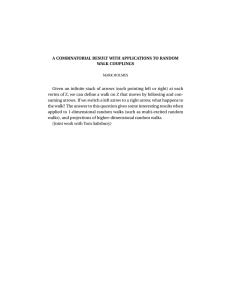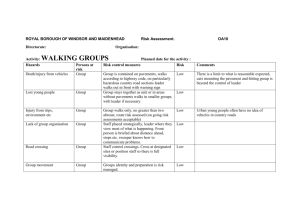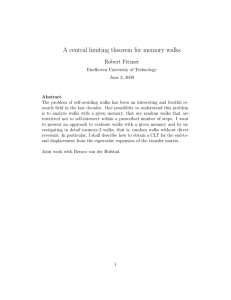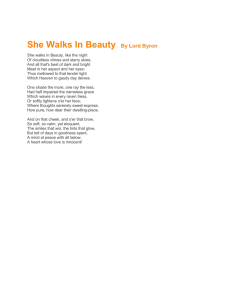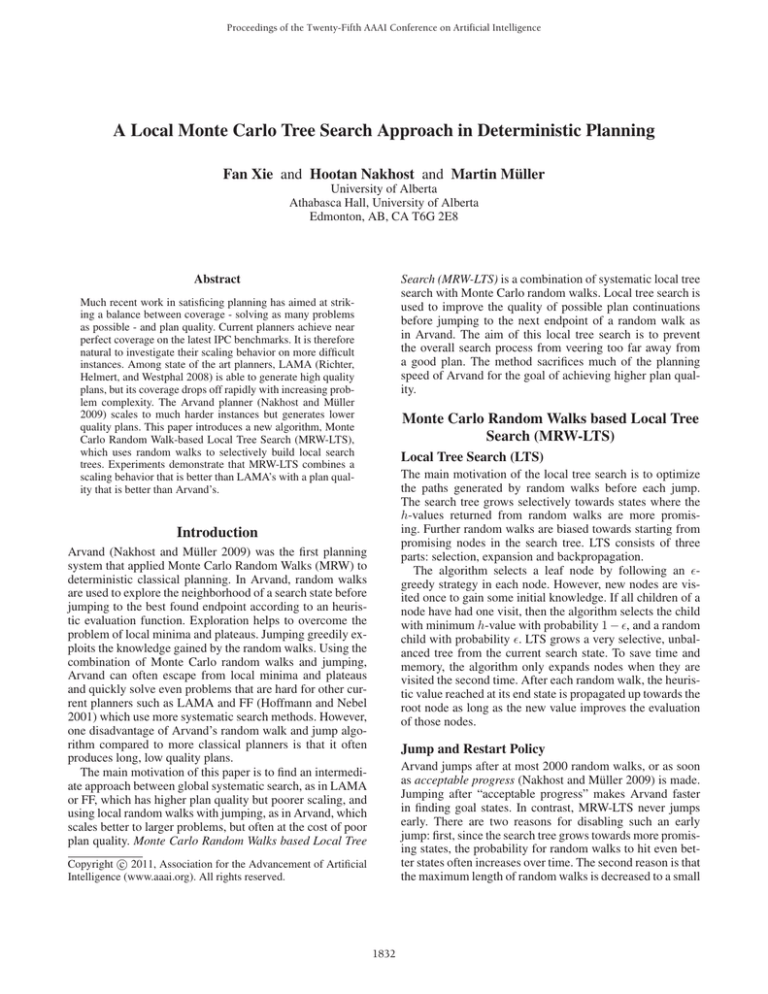
Proceedings of the Twenty-Fifth AAAI Conference on Artificial Intelligence
A Local Monte Carlo Tree Search Approach in Deterministic Planning
Fan Xie and Hootan Nakhost and Martin Müller
University of Alberta
Athabasca Hall, University of Alberta
Edmonton, AB, CA T6G 2E8
Search (MRW-LTS) is a combination of systematic local tree
search with Monte Carlo random walks. Local tree search is
used to improve the quality of possible plan continuations
before jumping to the next endpoint of a random walk as
in Arvand. The aim of this local tree search is to prevent
the overall search process from veering too far away from
a good plan. The method sacrifices much of the planning
speed of Arvand for the goal of achieving higher plan quality.
Abstract
Much recent work in satisficing planning has aimed at striking a balance between coverage - solving as many problems
as possible - and plan quality. Current planners achieve near
perfect coverage on the latest IPC benchmarks. It is therefore
natural to investigate their scaling behavior on more difficult
instances. Among state of the art planners, LAMA (Richter,
Helmert, and Westphal 2008) is able to generate high quality
plans, but its coverage drops off rapidly with increasing problem complexity. The Arvand planner (Nakhost and Müller
2009) scales to much harder instances but generates lower
quality plans. This paper introduces a new algorithm, Monte
Carlo Random Walk-based Local Tree Search (MRW-LTS),
which uses random walks to selectively build local search
trees. Experiments demonstrate that MRW-LTS combines a
scaling behavior that is better than LAMA’s with a plan quality that is better than Arvand’s.
Monte Carlo Random Walks based Local Tree
Search (MRW-LTS)
Local Tree Search (LTS)
The main motivation of the local tree search is to optimize
the paths generated by random walks before each jump.
The search tree grows selectively towards states where the
h-values returned from random walks are more promising. Further random walks are biased towards starting from
promising nodes in the search tree. LTS consists of three
parts: selection, expansion and backpropagation.
The algorithm selects a leaf node by following an greedy strategy in each node. However, new nodes are visited once to gain some initial knowledge. If all children of a
node have had one visit, then the algorithm selects the child
with minimum h-value with probability 1 − , and a random
child with probability . LTS grows a very selective, unbalanced tree from the current search state. To save time and
memory, the algorithm only expands nodes when they are
visited the second time. After each random walk, the heuristic value reached at its end state is propagated up towards the
root node as long as the new value improves the evaluation
of those nodes.
Introduction
Arvand (Nakhost and Müller 2009) was the first planning
system that applied Monte Carlo Random Walks (MRW) to
deterministic classical planning. In Arvand, random walks
are used to explore the neighborhood of a search state before
jumping to the best found endpoint according to an heuristic evaluation function. Exploration helps to overcome the
problem of local minima and plateaus. Jumping greedily exploits the knowledge gained by the random walks. Using the
combination of Monte Carlo random walks and jumping,
Arvand can often escape from local minima and plateaus
and quickly solve even problems that are hard for other current planners such as LAMA and FF (Hoffmann and Nebel
2001) which use more systematic search methods. However,
one disadvantage of Arvand’s random walk and jump algorithm compared to more classical planners is that it often
produces long, low quality plans.
The main motivation of this paper is to find an intermediate approach between global systematic search, as in LAMA
or FF, which has higher plan quality but poorer scaling, and
using local random walks with jumping, as in Arvand, which
scales better to larger problems, but often at the cost of poor
plan quality. Monte Carlo Random Walks based Local Tree
Jump and Restart Policy
Arvand jumps after at most 2000 random walks, or as soon
as acceptable progress (Nakhost and Müller 2009) is made.
Jumping after “acceptable progress” makes Arvand faster
in finding goal states. In contrast, MRW-LTS never jumps
early. There are two reasons for disabling such an early
jump: first, since the search tree grows towards more promising states, the probability for random walks to hit even better states often increases over time. The second reason is that
the maximum length of random walks is decreased to a small
c 2011, Association for the Advancement of Artificial
Copyright Intelligence (www.aaai.org). All rights reserved.
1832
value after a lower h-value (Nakhost and Müller 2009) is
found. Through the combination of the search tree and short
random walks, MRW-LTS very often finds shorter paths to
states with the same or better h-value.
MRW fails and restarts when the minimum obtained hvalue does not improve over several search steps, or when it
reaches a dead-end state. The restart policy of MRW-LTS is
more strict: If the minimum h-value does not improve within
a single search step, the search restarts from s0 .
However, LAMA, if it solves the problem, generally creates
a better quality plan.
The plan produced by local search in Arvand-LTS alternates between sequences generated systematically by local
tree search, and random walks. Arvand-LTS balances coverage and plan quality by combining the benefit of Monte
Carlo random walks in solving problems with the ability of
systematic search algorithms of producing shorter paths.
Experiments
Planning algorithms must address tradeoff between coverage and plan quality. Current state of the art planners seem
to emphasize either one or the other. The latest International
Planning Competition, IPC-2008, focused on plan quality
while the Arvand system focused on coverage. Arvand-LTS
represents a balanced approach by combining random walks
for increased coverage with systematic local search for plan
quality.
Important directions for future work are: 1. to increase speed by introducing a measure such as “acceptable
progress” 2. To generate better quality plans, action costs
should also be considered in the child selection function of
local tree search.
Conclusion
Experiments include tests on all IPC-2008 benchmarks, and
on scaled harder problems generated by IPC-2008 domain
generators. Experiments on IPC-2008 were run on a 3 GHz
machine and experiments on scaled hard problems were run
on a 2.5 GHz machine. The runtime limit was 30 minutes
and the memory limit 2 GB for each problem. Results for
planners which use randomization are averaged over 10 runs
per instance.
Experiments compare four planners: LAMA, the winner
of IPC-2008, as well as LAMA with Aras (Nakhost and
Müller 2010), Arvand and a preliminary planner ArvandLTS based on MRW-LTS. For improved performance, the
latter three programs run alternately with Aras to improve
each plan that is found.
In Arvand and LAMA, the cost of the best known plan before using Aras is used for pruning the search. For ArvandLTS, increased diversity is more useful, so it uses a different
bounding strategy. Arvand-LTS can run either with or without pruning based on the cost of the best plan. It first runs
3 times with and without pruning respectively, and prefers
the version which computed the smallest cost plan, however,
with with probability 0.2 randomly choose in each run.
In the experiment on IPC-2008 benchmarks, the total scores of LAMA, LAMA with Aras, ARVAND and
ARVAND-LTS are 233.96, 240.92, 228.4 and 234.2 respectively. Both ARVAND and ARVAND-LTS are competitive against LAMA. Most of the original problems in
IPC-2008 are easy for these planners, which solve around
90%. The following four domains of IPC-2008 have scalable
problem generators which allow the creation of harder instances: Elevator, Openstacks, Transport and Woodworking.
Figure 1 shows the average coverage and IPC-2008 score
of LAMA, Arvand and Arvand-LTS on the scaled Elevator problems. The scores are calculated by averaging solved
problem scores, and unsolved runs are ignored here to highlight plan quality. For large problems, Monte-Carlo Random
References
Hoffmann, J., and Nebel, B. 2001. The FF planning system:
Fast plan generation through heuristic search. J. Artificial
Intelligence Research 14:253–302.
Nakhost, H., and Müller, M. 2009. Monte-Carlo exploration
for deterministic planning. In Proc. IJCAI 09, 1766–1771.
Nakhost, H., and Müller, M. 2010. Action elimination and
plan neighborhood graph search: Two algorithms for plan
improvement. In Proc. ICAPS-2010, 121–128. Toronto, CA:
AAAI Press.
Richter, S.; Helmert, M.; and Westphal, M. 2008. Landmarks revisited. In Proc. AAAI-08, 975–982.
Figure 1: Average coverage (up) and scores (bottom) of
LAMA, Arvand and Arvand-LTS on scaled hard problems
of Elevator. The x-axis value is the number of passengers,
which is gradually increased to make problems harder.
Walk based approaches have much better coverage because
of the random walk local search which scales better than
systematic search. Systematic search can be slow to escape
from extensive local minima/plateaus, while random walks
lead to bigger jumps that help get away from such traps.
1833


